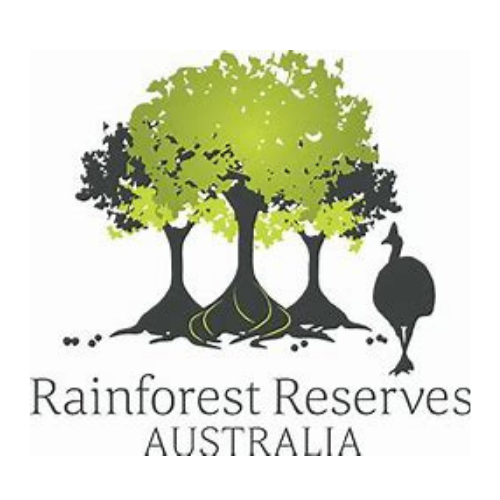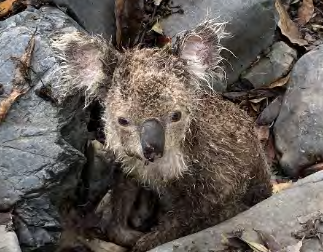
Capricornia Energy Hub (CEH) Transmission Project, Central Qld
Above: a koala surveyed onsite, seen in the proponent’s ecological surveys submitted to Government here.
Land to be cleared: Entire project area is 10022.32 ha, with a 214.81 ha disturbance “footprint.”
Project description: the project involves constructing new transmission lines that will connect Bowen Renewable Energy Hub (pumped hydro, solar farm, wind farm )to the grid.
It will be located about 80km west of Mackay and about 10km west of Eungella near the existing Eungella Dam, Central Qld.
It’s the first stage of the Bowen Renewable Energy Hub Pumped Hydro-electric Scheme. The development will:
It will involve a 275kV triple circuit overhead transmission line connecting the CEH PHES Project (EPBC Ref: 2023/09626) to the existing Powerlink 275kV Strathmore to Nebo transmission line (a direct line distance of about 17km);
2. A sub-station at the connection location to the Powerlink network to provide facilities for connection of the CEH Transmission Project to the grid;
Permanent access tracks;
Communications facilities; and
Temporary works such as access tracks and laydown areas. The transmission line will require a 90m wide easement.
Proponent: EUNGELLA INFRASTRUCTURE PTY LTD
EPBC referral here.
Threatened species to be significantly impacted by the development:
Greater glider (southern and central) (Petauroides volans)
A significance of impact assessment is provided in Att. 1 (CEH Transmission Project SIA 2023), section 5.4, pp 32 and is summarised below.
Habitats within the project area would be considered habitat critical to the survival of the species based on the extent of contiguous
woodland with mature hollow-bearing trees and a diverse range of preferred food species for the region.
Potential residual impacts on greater glider populations and habitat within the CEH Transmission Project include:
1. Loss of 77.53 ha of habitat critical to the survival of the species;
2. Disturbance to wildlife through increased light, noise and vibration;
3. Habitat degradation by increased dust run-off and sedimentation;
4. Introduction and spread of pest fauna species and weeds; and
5. Fragmentation and barrier effects.
Of the significant impact criteria relevant to Petauroides volans, it was assessed that it is likely that the CEH Transmission Project will adversely affect habitat critical to the survival of the species.
Grey-headed flying-fox (Pteropus poliocephalus)
A significance of impact assessment is provided in Att. 1 (CEH Transmission Project SIA 2023), section 5.5, pp 36 and is summarisedbelow:
Residual impacts on grey-headed flying-fox and the species’ habitat arising from the CEH Transmission Project include:
1. Loss of 115.26 ha of habitat critical to the survival of the species;
2. Loss of 42.61 ha of general foraging habitat;
3. Disturbance to wildlife through increased light, noise and vibration; and
4. Habitat degradation by increased dust, run-off and sedimentation.
Of the significant impact criteria relevant to Pteropus poliocephalus, it was assessed that it is:
1. likely that the CEH Transmission Project will adversely affect habitat critical to the survival of the species; and
2. possible that the CEH Transmission Project will modify, destroy, remove, isolate or decrease the availability or quality of habitat to the extent that the species is likely to decline.
Koala (Phascolarctos cinereus)
A significance of impact assessment is provided in Att. 1 (CEH Transmission Project SIA 2023), section 5.6, pp 40 and is summarised below.
Potential residual impacts on koala habitat arising from the CEH Transmission Project include:
1. Loss of 119.35 ha of habitat critical to the survival of the koala;
2. Loss of 37.74 ha of foraging habitat;
3. Barrier effects and restriction of koala movement;
4. Injury and mortality;
5. Habitat degradation by increased dust run-off and sedimentation; and
6. Introduction and spread of invasive weeds and pests.
Of the significant impact criteria relevant to Phascolarctos cinereus, it was assessed that it is:
1. likely that the CEH Transmission Project will adversely affect habitat critical to the survival of the species, and
2. possible that the CEH Transmission Project will interfere with the recovery of the species.
Northern quoll (Dasyurus hallucatus)
A significance of impact assessment is provided in Att. 1 (CEH Transmission Project SIA 2023), section 5.7, pp 44 and is summarised below.
Camera trapping undertaken across the local area within the transmission line investigation area and related PHES investigation area have not captured northern quoll records, suggesting the local northern quoll population is not high-density. However, Eungella, Crediton and
Clarke Ranges (areas all surrounding the transmission study area) are listed as important populations of the northern quoll in the National recovery plan for the northern quoll (Hill and Ward 2010). Within that broader context, the northern quoll population adjacent to the transmission line study area would constitute an ‘important’ population in that it contains high-density areas that have persisted long after cane toad invasion.
1. The construction of the transmission line has the potential to result in the following residual impacts on the northern quoll:
2. Loss of 132.37 ha of habitat critical to the survival of the species:
128. 70 ha of foraging habitat; and
3.67 ha of denning habitat.
3. Injury and mortality;
4. Habitat degradation by increased dust run-off and sedimentation;
5. Introduction and spread of pest fauna species and weeds; and
6. Fragmentation and barrier effects.
Of the significant impact criteria relevant to Dasyurus hallucatus, it was assessed that it is:
1. likely that the CEH Transmission Project will result in the loss of habitat critical to the survival of the species, and
2. from significant impact guidelines 1.1, likely that the CEH Transmission Project will adversely affect habitat critical to the survival of a species.
Yellow-bellied glider (south-eastern) (Petaurus australis australis)
A significance of impact assessment is provided in Att. 1 (CEH Transmission Project SIA 2023), section 5.8, pp 50 and is summarised below.
The yellow-bellied glider (south-eastern) has not been confirmed present in field surveys. Given the level of survey effort that has been undertaken for the project and the associated CEH PHES Project, the failure to detect the species has increased uncertainty over the species’ likelihood of occurrence. Targeted surveys are being undertaken in autumn and winter 2023 to further investigate the species’ likelihood of occurrence. Until those surveys are complete, a conservative approach has been taken and the species has been considered to have a high to moderate likelihood of occurrence given the presence of suitable habitat and nearby historical records.
Potential impacts on yellow-bellied glider population and habitat within the CEH Transmission Project include:
1. Loss of 39.59 ha of habitat critical to the survival of the species;
2. Disturbance to wildlife through increased light, noise and vibration;
3. Habitat degradation by increased dust run-off and sedimentation;
4. Introduction and spread of pest fauna species and weeds; and
5. Fragmentation and barrier effects.
Impacts on threatened species
This is a development which will significantly impact threatened wildlife and it’s habitat.
Petauroides volans (Greater glider)
Loss of 77.53 ha of habitat critical to the survival of the species associated with option 15 (76.40 ha for option 16);
Disturbance to wildlife through increased light, noise and vibration;
Habitat degradation by increased dust run-off and sedimentation;
Introduction and spread of pest fauna species and weeds; and/or
Fragmentation and barrier effects.
Pteropus poliocephalus (Grey-headed flying fox)
Loss of 115.26 ha of habitat critical to the survival of the species associated with option 16 (114.24 ha for option 15);
Loss of 42.61 ha of general foraging habitat associated with option 16 (46.66 ha for option 15);
Disturbance to wildlife through increased light, noise and vibration; and/or
Habitat degradation by increased dust, run-off and sedimentation.
Phascolarctos cinereus (Koala)
Loss of 119.35 ha of habitat critical to the survival of the koala associated with option 16 (118.52 ha for option 15);
Loss of 37.74 ha of foraging habitat associated with option 16 (41.85 ha for option 15);
Barrier effects and restriction of koala movement;
Injury and mortality;
Habitat degradation by increased dust run-off and sedimentation; and/or
Introduction and spread of invasive weeds and pests.
Dasyurus hallucatus (Northern quoll):
Loss of 132.37 ha of habitat critical to the survival of the species associated with option 16 (132.15 ha for option 15) ;
128.7 ha of foraging habitat associated with option 16 (129.99 ha for option 15);3.67 ha of denning habitat associated with option 16 (2.16 ha for option 15).
Injury and mortality;
Habitat degradation by increased dust run-off and sedimentation;
Introduction and spread of pest fauna species and weeds; and/or
Fragmentation and barrier effects.
Geophaps scripta scripta (Squatter pigeon - southern):
Loss of 14.33 ha of habitat critical to the survival of the species (nesting habitat) associated with option 15 (3.26 ha for option 16);
77.33 ha of foraging habitat associated with option 15 (90.02 ha for option 16);
15.78 ha of drinking habitat associated with option 15 (10.46 ha for option 16).
Injury and mortality;
Disturbance from increased light, noise, and vibration;
Habitat degradation through increased dust, run-off, and sedimentation; and
Introduction and spread of invasive fauna species and weeds.
Petaurus australis australis (Yellow-bellied glider (south-eastern)
Disturbance to wildlife through increased light, noise and vibration;
Habitat degradation by increased dust run-off and sedimentation;
Introduction and spread of pest fauna species and weeds; and / or Fragmentation and barrier effects.
Hirundapus caudacutus (White-throated needletail)
Loss of 1.11 ha habitat critical to the survival of the species (roosting) associated with option 16 (1.10 ha for option 15); and
Loss of 131.26 ha of overfly habitat associated with option 16 (131.08 ha for option 15).Indirect impacts may occur through light, noise, dust and vibration, habitat degradation through sedimentation, introduction of weeds and / or pests, and fragmentation and barrier effects



